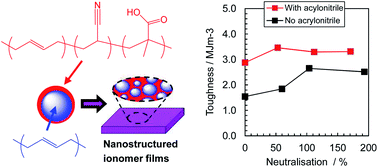The role of acrylonitrile in controlling the structure and properties of nanostructured ionomer films†
Abstract
Ionomers are polymers which contain ionic groups that are covalently bound to the main chain. The presence of a small percentage of ionic groups strongly affects the polymer's mechanical properties. Here, we examine a new family of nanostructured ionomer films prepared from core–shell polymer nanoparticles containing acrylonitrile (AN), 1,3-butadiene (Bd) and methacrylic acid (MAA). Three new AN-containing dispersions were investigated in this study. The core–shell nanoparticles contained a PBd core. The shells contained copolymerised Bd, AN and MAA, i.e., PBd-AN-MAA. Three types of crosslinking were present in these films: covalent crosslinks (from Bd); strong physical crosslinks (involving ionic bonding of RCOO− and Zn2+) and weaker physical crosslinks (from AN). We examined and compared the roles of AN and ionic crosslinking (from added Zn2+) on the structure and mechanical properties of the films. The FTIR spectroscopy data showed evidence for RCOOH–nitrile hydrogen bonding with tetrahedral geometry. DMTA studies showed that AN copolymerised within the PBd-AN-MAA phase uniformly. Tensile stress–strain data showed that inclusion of AN increased elasticity and toughness. Analysis showed that about 33 AN groups were required to provide an elastically-effective chain. However, only 1.5 to 2 ionically bonded RCOO− groups were required to generate an elastically-effective chain. By contrast to ionic bonding, AN inclusion increased the modulus without compromising ductility. Our results show that AN is an attractive, versatile, monomer for increasing the toughness of nanostructured ionomers and this should also be the case for other nanostructured polymer elastomers.


 Please wait while we load your content...
Please wait while we load your content...